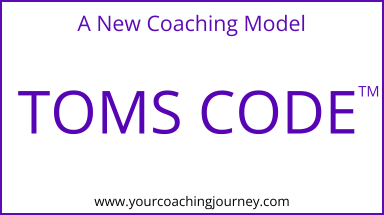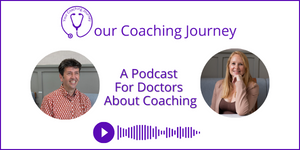Prefer to listen?
This blog post forms the basis of a podcast on our new coaching model, which you can listen to here.
Why Do We Need A New Coaching Model?
I have been coaching training for a number of years, probably ten years now, alongside that I’ve also been doing some form of coaching training, and we’ve been running a transformational coaching diploma since 202. In the past we’ve used the G.R.O.W. model, which is a perfectly fine model. It’s been around a long time. It was created by John Whitmore, who wrote a book called Coaching for Performance. And I think most organisations would embrace the G.R.O.W. model because it’s very dynamic:
- what’s your goal
- what’s happening at the moment
- what are your options
- and how are you going to get there?
It’s very action focused, so it moves people forward and obviously if you’re managing someone or involved in organisational structures, that’s great. You want something to happen. I’ve looked at other models that are available like CLEAR and OSCAR and they are more or less the same, so I’ve never felt inclined to stray away from the grow model.
But having been training people for some time and doing lots of training now with doctors around coaching, it’s become apparent that it’s not really fit for purpose, which is a bit difficult to say, having trained everyone with the G.R.O.W. model.
I’ve just come to the realisation from watching people get to grips with coaching, that it doesn’t flow in the way that a coaching conversation might. So, I set about trying to create a model that flowed more easily than the G.R.O.W. model.
If you think about the grow model, it stands for
- Goal,
- Reality,
- Options, and
- Way forward.
But quite often, people don’t come with a goal. They come because there’s something going on and they want to talk about something. There’s something that’s not sitting right with them, so they come wanting to have a conversation about it, which is what we do so, the goal quite often isn’t there at all at the beginning.
A New Model For Coaching With Or Without a GOAL in mind
I set about trying to create a new model. And I have sat for many hours trying to create something I could fit into a neat acronym and have it spell out something, and I finally came up with something which works whether a person has goal, or if we are helping someone to do more thinking around a topic. And here it is:

Let’s explore what it means.
T is for TIME and TOPIC
TIME: Obviously, we will have a specific amount of time with our coaching client, and and it’s good to confirm this at the start of our conversation, “We have an hour today”. This also helps us to not run over and set our boundaries right from the start.
TOPIC: Everyone comes to coaching with something on their mind that they want to talk about and it’s good practice to clarify what that is straight away. So we can add the second part of our opening is “What would you like to give some thought to today?”.
O is for OUTCOME
This is the outcome for today’s session based on the topic and the amount of time that we’ve. The coachee might say that they want to change their life completely, which is probably not going to fit into an hour. We will need a few more sessions for that, but we can make a start. Asking the Coachee, “What would you like to take away from this Conversation?” is a good Place to start.
Other questions here could be:
“What would you like to have by the end of this conversation?
“What would be a good outcome for this Conversation?
Note: We only need to ask one of these.
They might bring something fresh that’s just happened that morning, something’s just been sprung upon them, something that they particularly want to discuss, something might have changed since you last saw them, or something new might have happened.
M is for MEANING
This is a bit of sense checking to ensure that this is really what they want to bring to coaching. Is this an important topic for them to bring to coaching?
My question to the coachee is,
“What about this makes it important for you to bring to coaching today?”
Note: It may be that they’re talking about some life changing event and it’s clearly very important. So I wouldn’t be asking that question in that circumstance. I will change it for a different ‘meaning’ question. Something like, “You have a desired outcome for this session. If you have managed to achieve that desired outcome by the end of this session, what would that give you? Or, What would that mean to you?
This allows us to have a sense of how important it is for them and gets them to think about it.
We have to be careful that we’re not judging. We’re in a non judgmental space, so it’s not for us to decide what’s important for the coachee. But some sense checking is good at that point.
S is for SITUATION
This is what’s going on at the moment that makes this an issue. It’s the REALITY in the G.R.O.W model.
We’re exploring that situation and this is the space where we might enter that person centered zone of allowing them just to talk freely. And it might take the whole of the session for them to explain what’s going on and how they’re feeling about it and what it means to them to be in the situation that they’re in. I don’t, therefore, feel as if I have to shut that conversation down or interrupt them to move them on. I’m happy for them to do their exploring at that point. This is their space and I’m just going to sit and listen and ask questions. I’m not going to dig too deep into the detail. I don’t need to know the detail, but I want to understand their world and get a sense of their world.
It’s also a good place to explore their limiting beliefs, perhaps, or their assumptions about what’s going on.
C is for CHANGE
We work in transformational coaching. We’re looking for something that the coachee wants to work with that’s going to bring about change. And what I find is that most coachees want to see something change in their life. They might not have a specific goal, but there’s some change that they want to see.
- they’re not comfortable with the situation,
- they want to change something about themselves,
- they want to move forward with something.
So this section of the model is very much about exploring what that change might be. This is where I get to ask my favourite question:
“What would you like to have happen?”
I don’t always ask that question, but it’s great when people are locked in a situation and they’ve told you their tale of what’s going on at the moment, that question, may unlock their thinking about. Other similar questions might be:
“What would you like to move towards?”
“What’s the change you want to see?”
“What does success look like if you manage to effectively achieve your desired outcome?”
O is for OPTIONS
There’s two parts to this. Firstly, we will be looking to generate as many options as we can, perhaps with a bit of brainstorming. Let’s just get as many options out there as we can.
Let’s imagine someone coming to a fork in the road and they can’t decide whether to go left or right, metaphorically, in life? Now, if you come to a fork in the road, those aren’t your only options. You could stay where you are, you could go back the way you came, you could get on a plane and go up above the roads, you could dig a tunnel, you could sit and have a picnic and rest for a while. There are all sorts of options that you have when you come to a fork in the road. And this is a time not to think about the being silly ideas, sometimes we’ll say, “what’s your craziest option here?”
Secondly, we want to explore each of them and see what are practical options, and what are inspiring options for the coachee. What’s going to motivate them to move forward with that option? Because coaching is all about how we move ourselves forward, whether that’s in our thinking or in actions we’re going to take. We want there to be some forward momentum so narrowing down the options gives us that chance to actually think about how we might move forward with those options.
D for DIRECTION
This is where we’re going to choose one, maybe two, or even three of those options to action or focus on. There might be options that can run simultaneously, so, there might be two, three options they want to take. Then we start with picking one. This is how they’re going to move forward.
We can then explore how are they are going to do that. This part of the model is where we might be using a solution focused approach. For example, we might ask
“What’s the first step you’re going to take that allows you to move forward?”
“What’s the first step you could take?”
“Who will you talk to?”
“If you are going to do it, what deadline will you set for yourself?”
“On a scale of one to ten where one is no, I’m never going to do it in a million years. And ten is ‘I’m definitely going to do it as soon as we finish this coaching session, where are you on that scale?
“What is it that’s getting in the way of that?”
It might well be the next step, is to go away and do some more exploration or a bit of research, some due diligence on what it would mean because there may be consequences to taking those actions as well.
It might be action isn’t what’s necessary as the next step. It could just be some more thinking and maybe some more research.
E for EXPLORE
This is all about exploring the coaching session, exploring the thinking that has just gone on. My definition of coaching is a conversation that generates new thinking on the part of the coachee, so, I want them to have done some new thinking within that coaching session. I’m then interested for them to reflect and to think about what they have thought about in the session, so I might say to them,
“What do you know now that you didn’t know at the beginning of this session?”
It’s a lovely question and it does create some pause in the conversation for them to sit and think, bit of reflection, and it’s good for me to have that space to reflect as well. And I might offer my perspective on where they’ve come in that coaching conversation.
Also, the S or situation in the model might take the whole of a session and you might need to come back to the rest of the model on the next session, so, you could actually ask that exploratory question at the end of the first session to see what they’ve discovered just in talking about their current situation.
It’s Twice The Length Of The G.R.O.W. Model, How Long Does This Take?
We don’t have to go through the whole model in one coaching session, you might spread this out over perhaps two or more sessions, but it’s also possible to use this code from start to finish in a 20 minute coaching session, so it’s quite possible for it to be quite quick.
Do We Need A Model At All?
Some people are a bit sceptical about having models, but I think it’s useful for us to have a framework. It’s useful to know where you are in the conversation, particularly when you’re learning to coach, just to have something, some way of flowing through a conversation. And I think TOMS CODE offers that framework.
It feels more nuanced than G.R.O.W. There seems to be more flow to it and that we can go a bit deeper with certain elements.
Most importantly, the feedback we’ve had from new and experienced coaches alike, has been that they like this model a lot and find it really useful for all sorts of coaching conversations. So if you’d like to try it, you can access a copy of TOMS CODE to refer to here: https://yourcoachingjourney.com/toms-code-pdf-download/
And we also have a podcast episode in which we share a demo of us using this model. You can listen to that coaching demo here:https://yourcoachingjourney.com/project/episode-33-coaching-demo/
To find out more about our Doctors’ Transformational Coaching Diploma click through here



